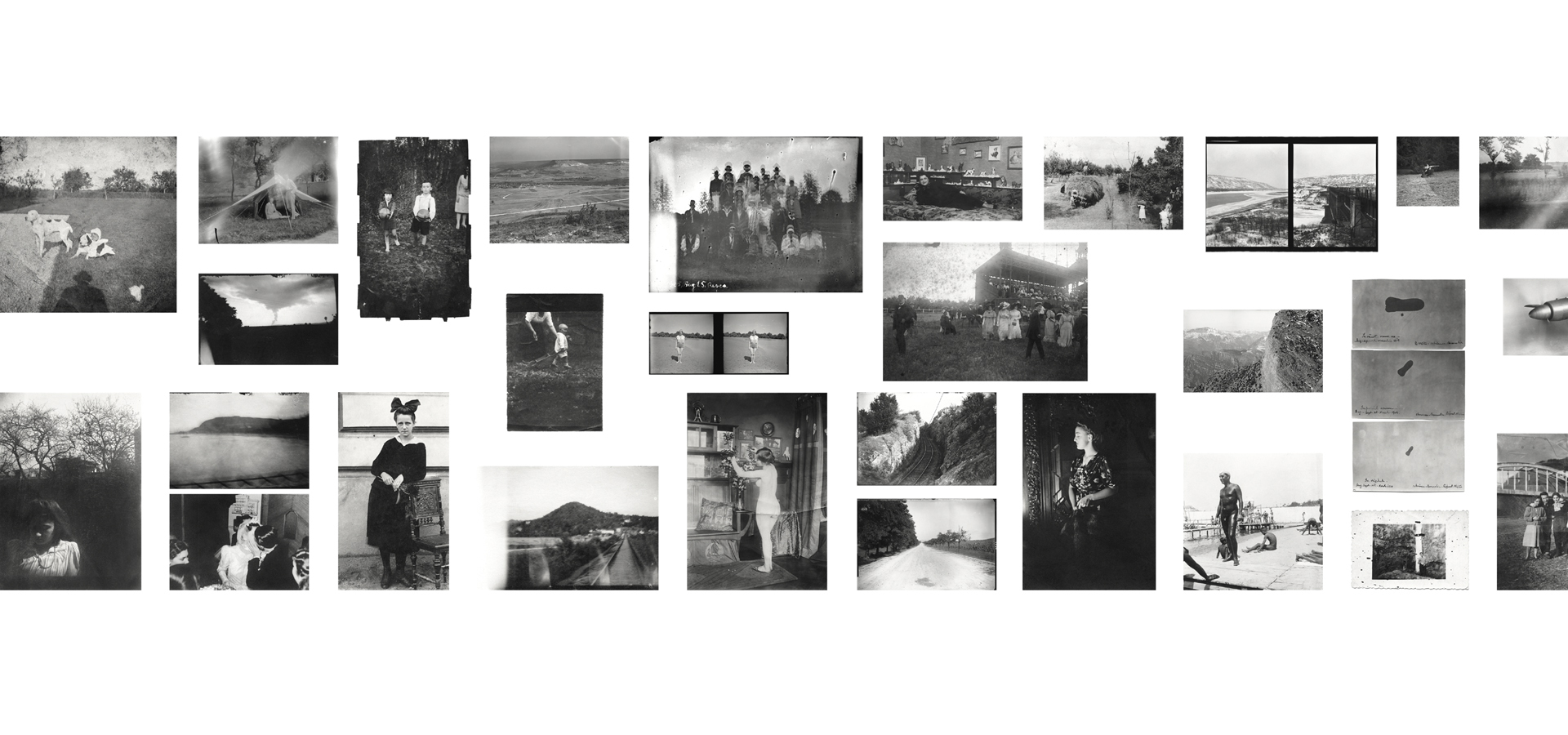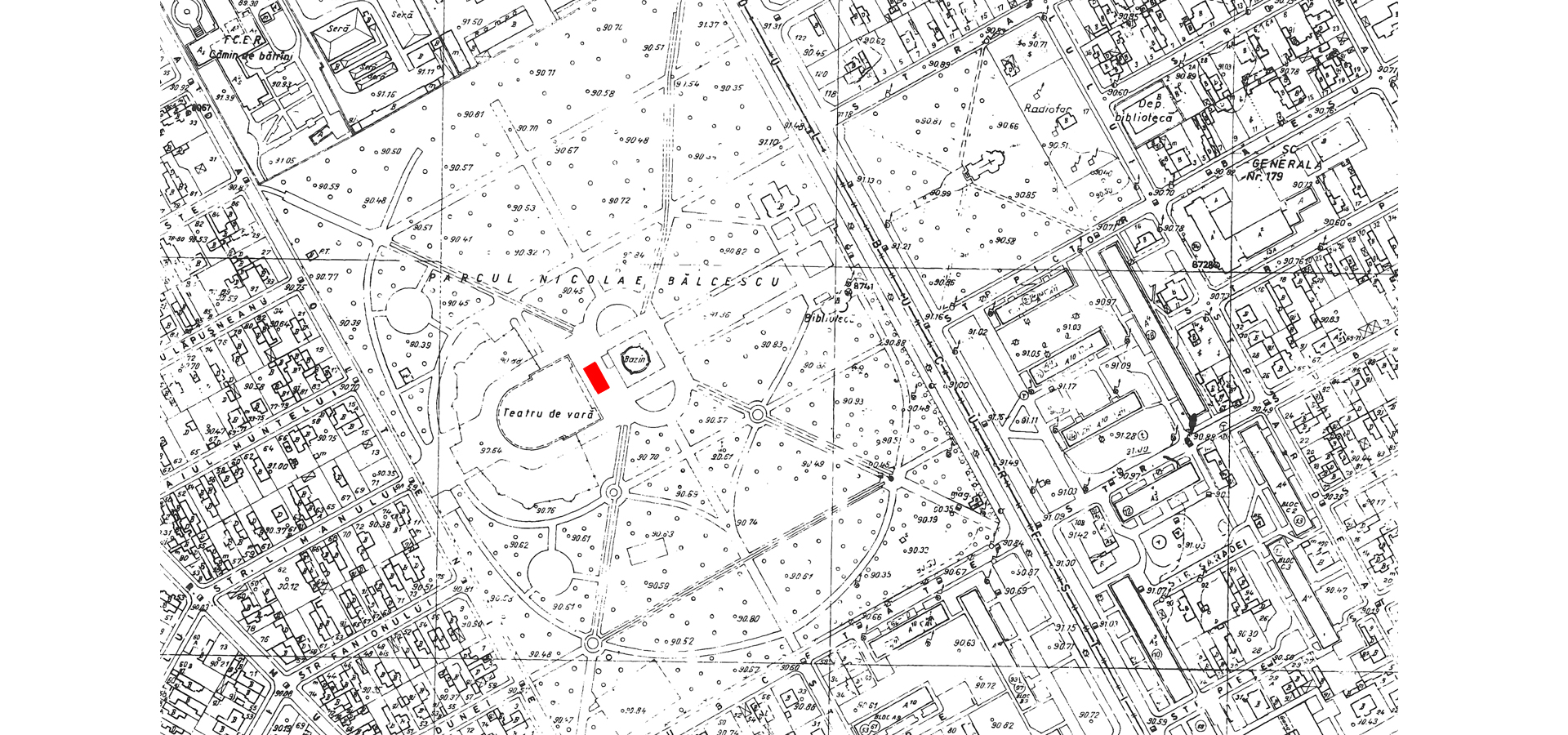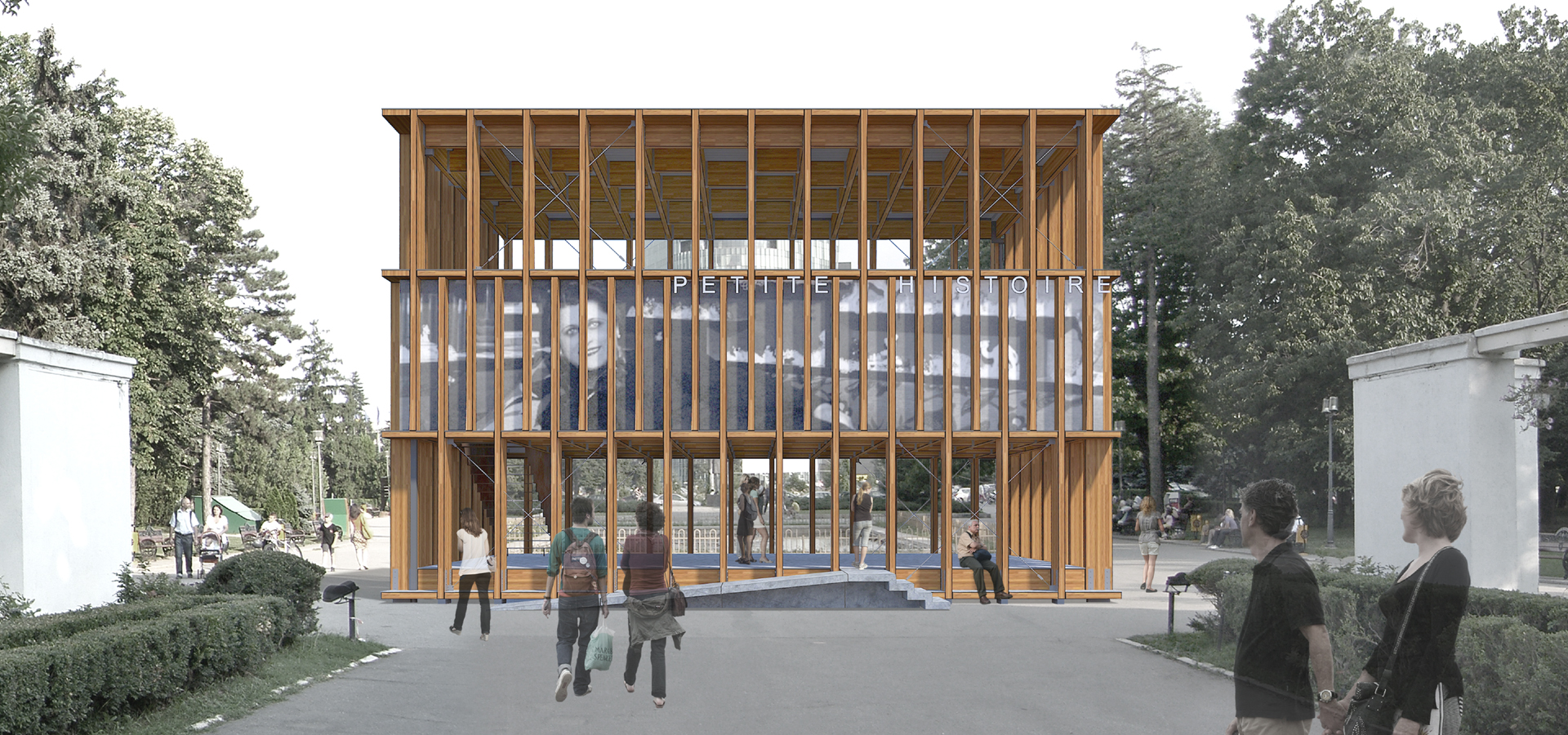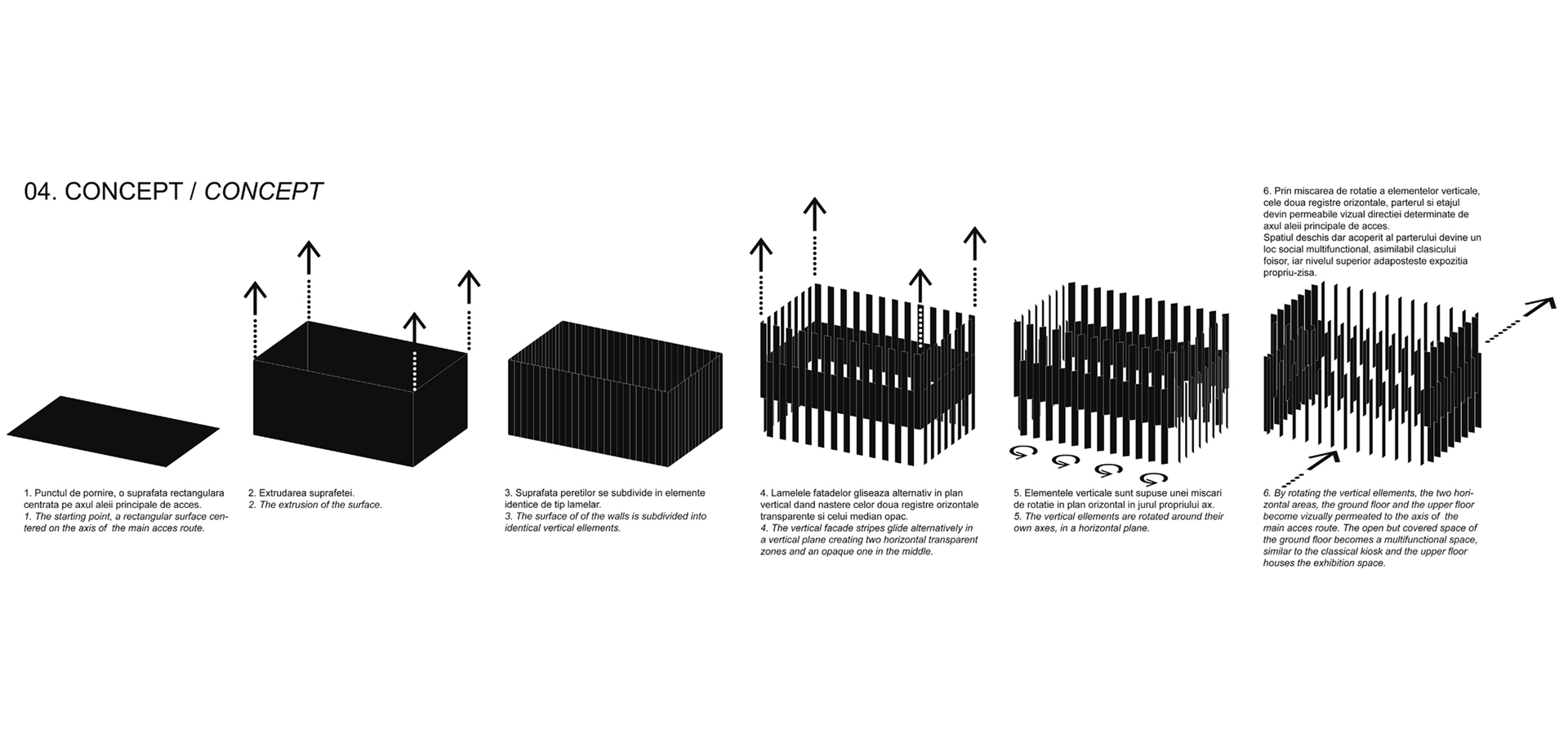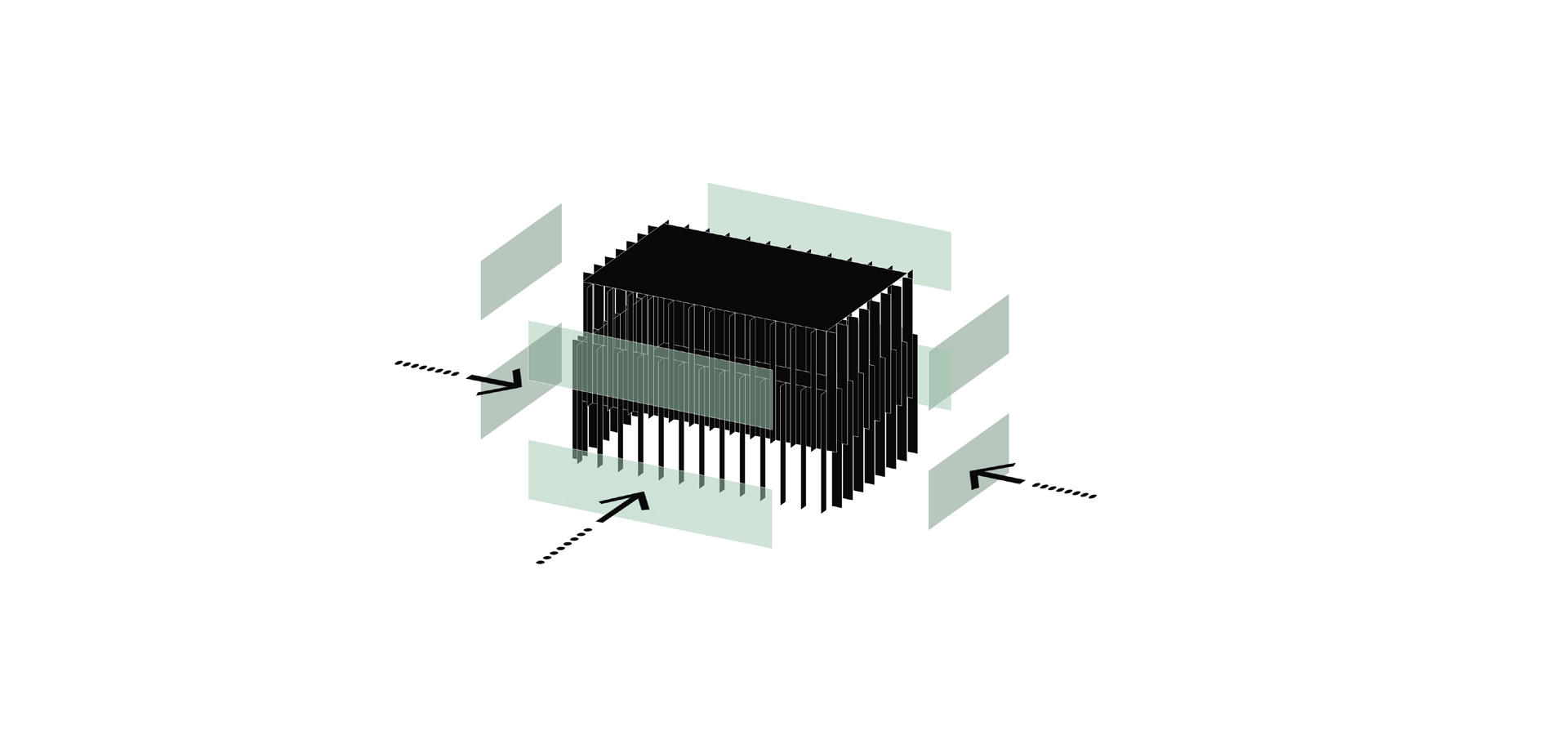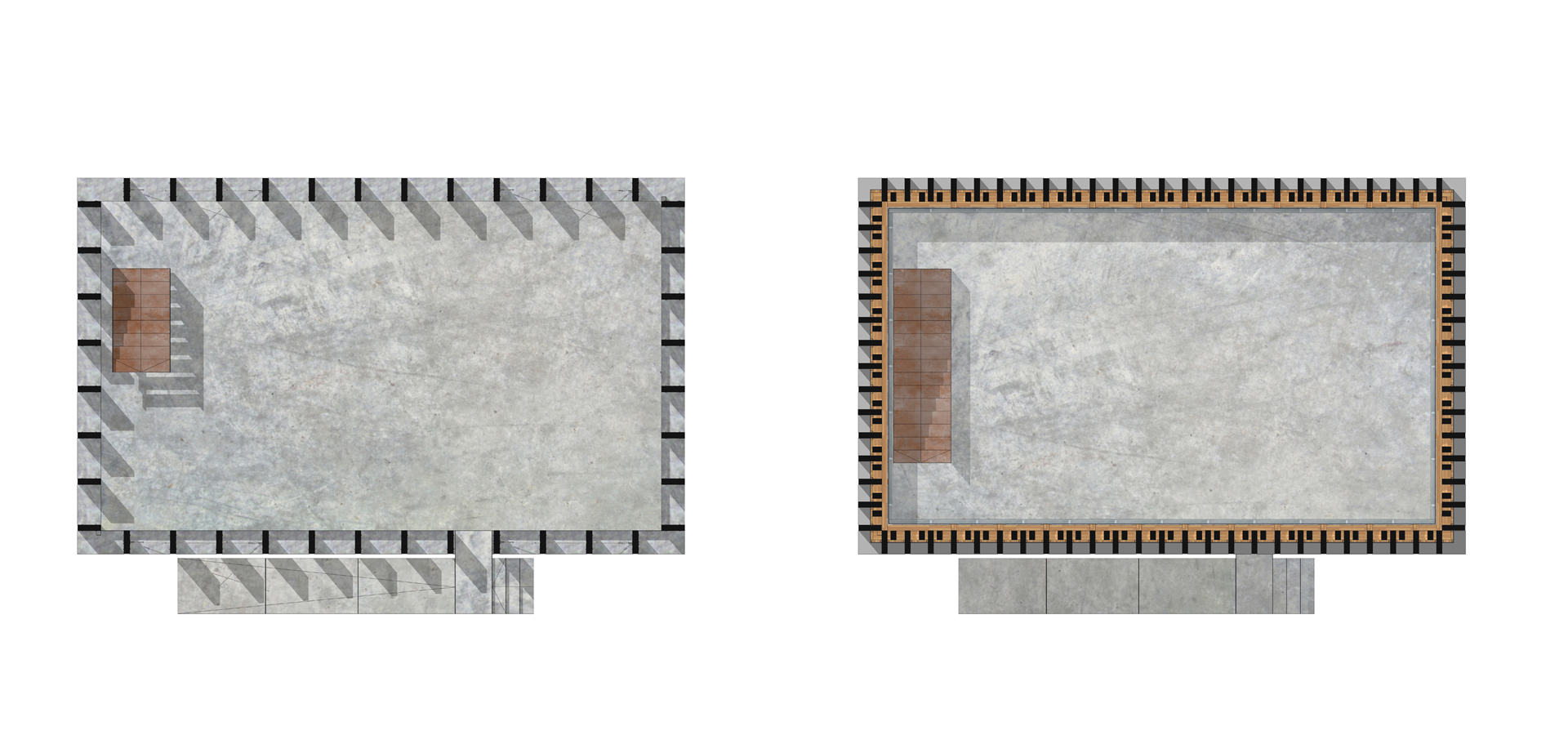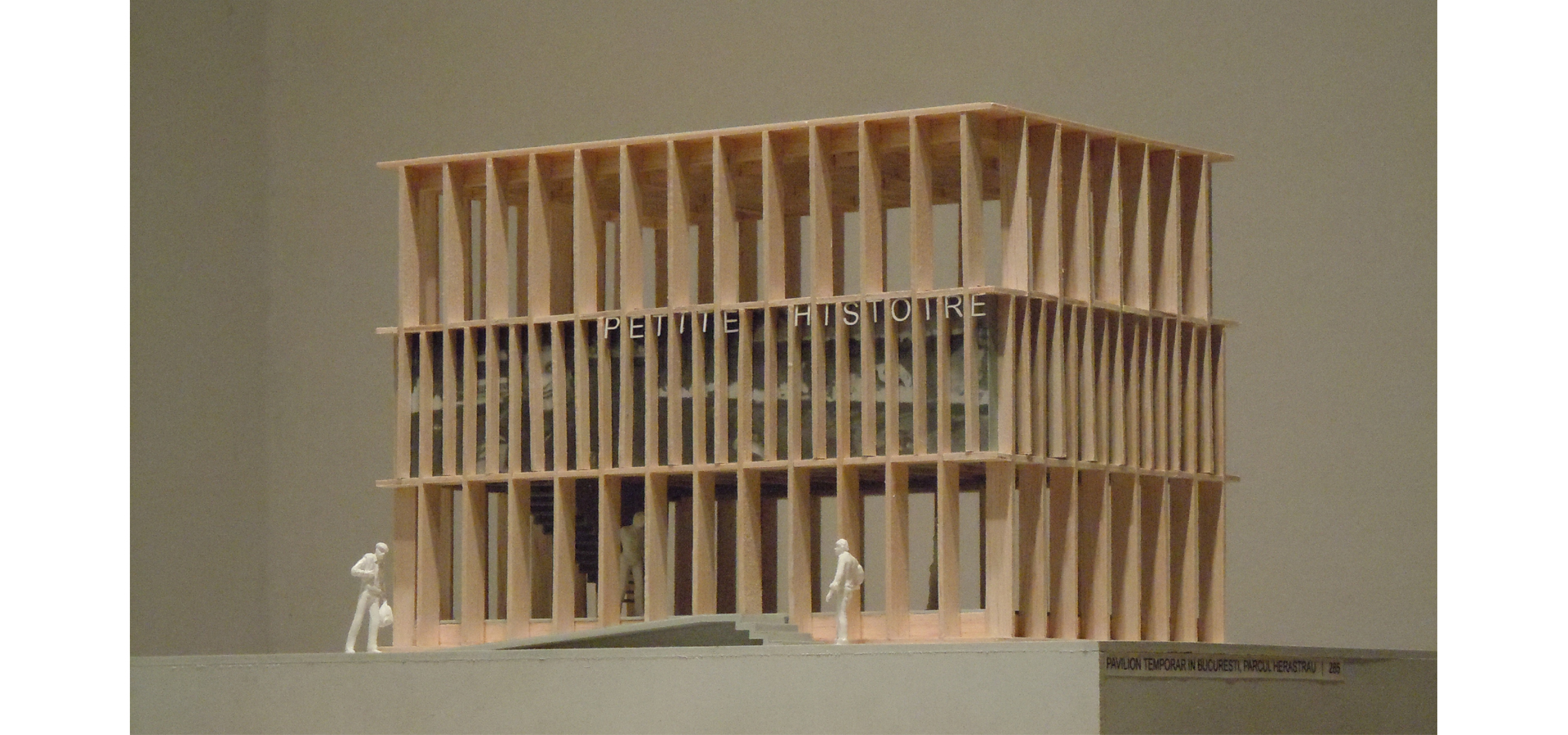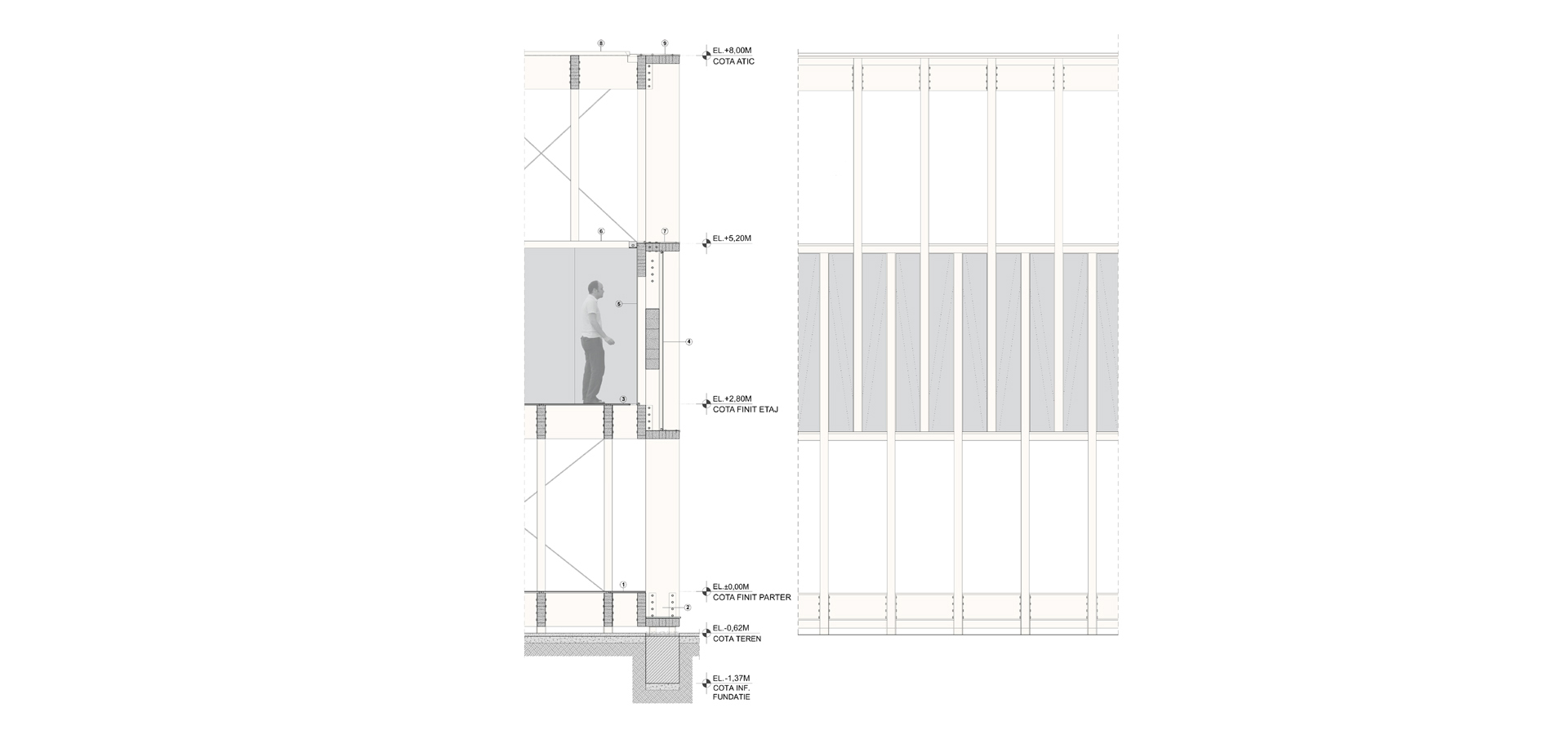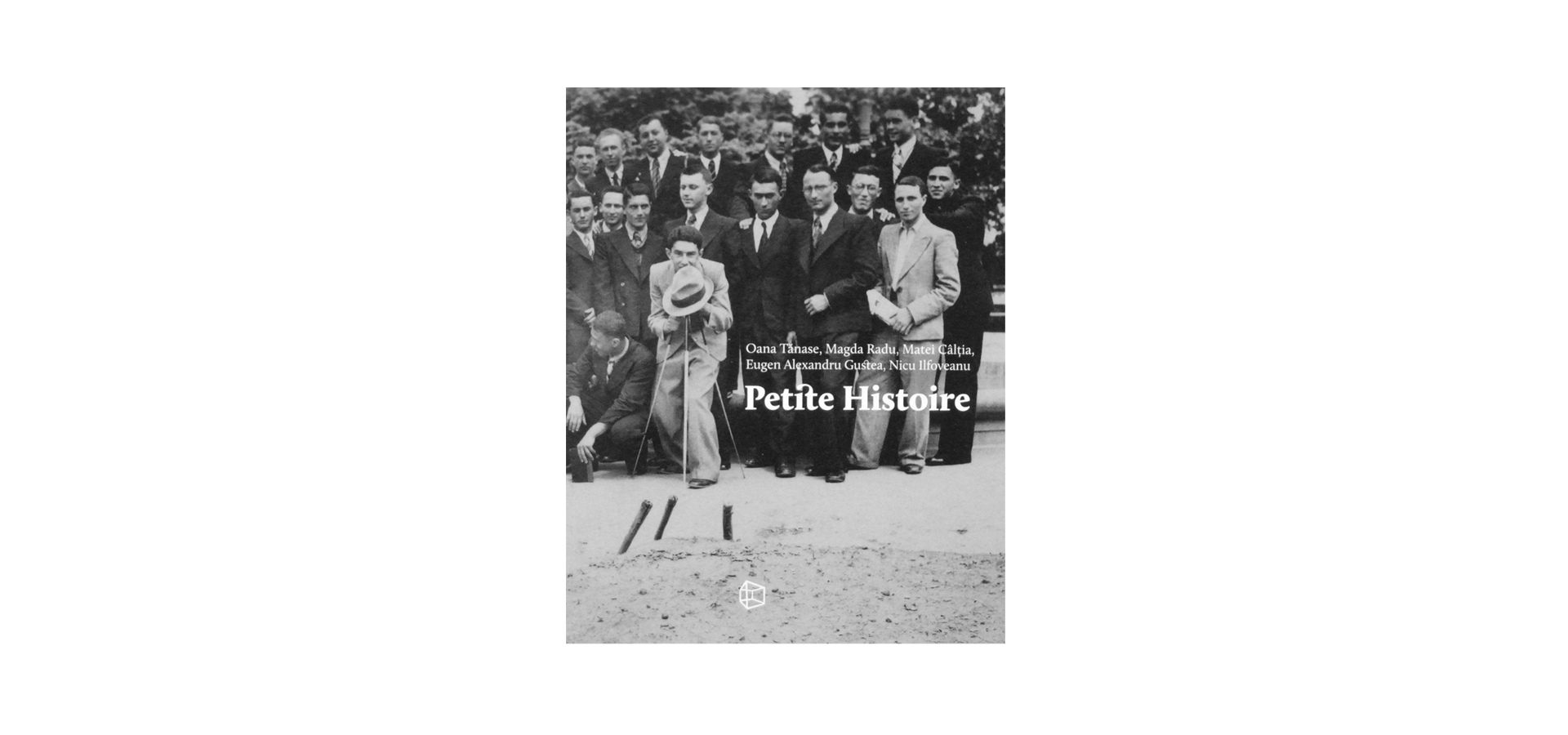
Archetypes Pavilion Competition
View project description2010Competition Archetypes Pavilion Competition
2010 / Competition / Archetypes Pavilion Competition
Honorable mention / second phase selection
Location: Bucharest, Romania
Project Status: Competition
Architecture: E+EA – Mihai Ene, Adela Ene, Stefan Cristescu
Structure: Profesional Construct – Paul Ioan
Client: Romanian Architect’s Union
Surface: 200 sqm
Period: 2010
Renders: E+EA
01. PRETEXT
At the end of 2009 a group* of artists, art critics and curators has finalised a unique visual project in Romania, entitled Petite Histoire and materialised in the form of a book and an exhibition hosted by Galeria Posibila.
At the time we applauded the initiative and appreciated the result. The pretext of this architectural design competition gives us the chance to try to complement this notable cultural event by creating a temporary pavilion with the aim of exposing this project to a much wider audience. It is our conviction that such a subject would manage to stir the general interest, due to the many ways that a cultural event of this nature can be deciphered.
*Oana Tanase, Magda Radu, Matei Caltia, Eugen Alexandru Gustea, Nicu Ilfoveanu
02. SUBJECT
Originality is a common place in art, nevertheless an artist is valued when he continues and refines the work of another that precedes him. Educated in a country that can hardly boast of traditon when it comes to photography, we felt the need of predecessors. Somehow we had in mind a description by Borges of the similitudes existing between Kafka’s stories, written at the turn of the XX th century and Hawthorne’s, dating from the debut of the XIX th century, which makes the latter a precursor of Kafka, to whom he actually owes being discovered and reinterpreted: “The debt is mutual; a great writer creates his precursors. He creates and somehow justifies them.” 1.
In our case, whithout pretending to be “great artists”, we create some unknown precursors, to justify ourselves as artists. Photography as medium allows that. Has it been our intention to make of the present work an exclusive rediscovery, through contemporary eyes, of a whole arsenal of archive photography images circumscribed to the Romanian space? Maybe not. Rather we aimed at spelling out a visual and conceptual discourse on the photography medium memory, on what the photographed image is able to convey when its author, subject, motivation and context have faded away with the passing time.
Paradoxically, the long silent interval lying between the instant when the camera shot and the present one, when we behold these images taken out of context, manages to bestow upon them unexpected purpose and depth, despite the loss of their original contents and initial significance. Viewed from this perspective the present volume is more of an exercise on the photography medium magic, on its capacity to generate contents, emotion and significance beyond the author’s option or the subject
represented. We are aware that the line of thought we suggest when reading these images is a subjective one, bearing the mark of our own sensitivities and aesthetic affinities, still it was our concern to let the visual story unfold in an open and many-sided ways, capable to induce to the onlooker his or her own itinerary.
1. J. L. Borges “OtherInquisitions” 1964.
(Nicu Ilfoveanu & Eugen Alexandru Gustea)
03. DECLARATION OF INTENT
In 2009 Galeria Posibila has started a project concerning the reevaluation of contemporary Romanian photography. Petite Histoire is an essay about vernacular and accident in photography, signed by Oana Tanase, Magda Radu, Matei Caltia, Eugen Alexandru Gustea si Nicu Ilfoveanu.
The book Petite Histoire focuses on the anonymous photography in Romania, but without the intention of being neither a history nor a nostalgic album. Imagined starting from material selected from different collections, Petite Histoire aspires to be a fresh essay, a contemporary interpretation of author-less images, a book that broadens our perspective towards experiment and failure in photography. A series of texts completes this approach and explains the relationship between contemporary thinking and the intimacy of the experimantalism of photographs made by amateurs. From the beginning, the project has taken into consideration paths started by Tacita Dean, Martin Parr and others, but its particularity resides in the geography that the photographic production inhabits. This first book of a larger series that the authors intend contributes to the understanding of photography in Romania and of an estetic proposed by contemporary artists.
Therefore, we beleve that the appearance of a Petite Histoire pavilion will lead to an increase of activity, being an excellent place to popularize the project and involve others in it.
More exactly, in the event that the pavilion becomes reality, Galeria Posibila engages to curate and promote two exhibitions and two conferences in this space, on the subject of anonymous photography. We also believe that the friends of this project, Mr. Mihai Oroveanu, Mr. Alex Galmeanu will be at our side by proposing discussion or exhibition themes. We would like to extend the implication in this project by inviting along artists or photographers – writers, literary critics, architects, ethnographers, philosophers etc. thus expanding the theme from a view upon anonymous photography to a series of discussions and exhibitions imagined around the idea of anonymous creation in contemporary society. We hope that two new publications that will continue the series started by Petite Histoire could be ready soon and launched in the pavilion, assuring dynamism to the entire space. Therefore, a number of at least four or five exhibitions and an equal number of conferences will take place in this space for the duration of a year, confirming the pavilion as a unprecedented reference of Herastrau Park and as a particular reference of Bucharest cultural life.
The project of the pavilion by ENE+ENE ARHITECTURA has the advantage of the possibility of relocation and transformation into a permanent, enclosed and secure space with relativly low costs. Given the possibility of the relocation in a new site, maybe in the same park, Galeria Posibila offers its intention to continue, even in a more dynamic manner, an extensive plan for exhibitions dedicated to photography in in an extended sense, explore the relations-implications that it has with different fields, ranging from literature and art to industry and private life. Therefore, for us, the opportunity of a space so open and friendly in its nature, will also bring the provocation of transforming the closed discourse that our present closed circuit gallery presently has into a discourse both novel and open, accessible but surprising to the varied public that will visit. This will be a fulfilment of our wishes for some time now to bring the general public closer to new concepts and ideas of contemporary culture.
Matei Caltia
Galerist
Galeria Posibila
04. OBJECT
From the beginning we wanted to create an architectural object imagined around a powerful content. We believe that such an approach can stir the interest of visitors in a much more convincing manner and for a far longer period of time than a mere exercise in architectural form, inevitably exhausted after the first dechiphering.
Having the advantage of a highly circulated pedestrian zone, the chosen site offers the possibility of installing an object capable of delivering a cultural experience, in the form of exhibitions and events with connected themes.
By means of a succession of manipulations of an initial box we arrive at a volume with two interior open spaces – a multifunctional, belvedere-type space at ground floor, and a gallery on the upper floor.
The modular, glulam wooden structure uses a single section for all the elements that it is comprised of – pillars or beams – 120 mm x 500 mm. All the connections between the wooden parts are made of galvanized steel and are secured by steel bolts. The entire structure of the building can be dismantled and reused, because of the modular nature of its design.
The two access elements – the welded steel staircase between the two floors and the exposed concrete ramp that is used to access the ground floor – are prefabricated elements that are simply installed on the building site.
The concept of the exhibition pavilion is based not only on a socializing and meeting space, but also on the idea of an architectural object that through its image and content can become an icon for the area, with a positive, lasting effect on its visitors.
05. TRANSFORMATION
Our intention was to imagine a fully reusable architecture. We feel that a financial effort that results in an object with a lifespan of only one year is difficult to justify in the current economic context. For this reason we envision the following scenario:
at the end of the year as a temporary object, with the help of some minimal investments, the project can be transformed into a permanent object, relocated in another site, preferably still in Herastrau Park. By enclosing the two open surfaces on the ground and upper floors in thermal efficient glass, insulating the opaque parts of the upper floor and the terrace, minimal pieces of furniture and installation, one can obtain a permanent gallery with two spaces: an 86 sqm exhibition space on the top floor and a similar one on ground floor for reception/exhibition openings/library/conferences. As it was previously explained, a young and competent curatorial team is presently ready to give life and maintain such a rare endeavor.
An architecture with a life after death – this is our proposal.
